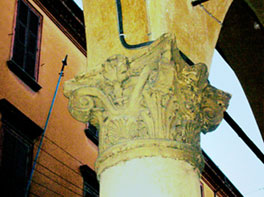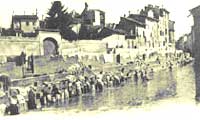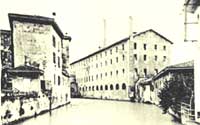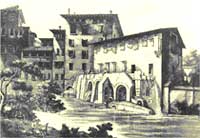|
BED AND BREAKFAST IN BOLOGNA ACCOMMODATION IN BOLOGNA ERBORISTERIA WEBMASTER |
||||||
|
|
In 1900 the demolition of the walls, according to the
1889 town-plan, marked
the coming of
the new century; by then the middle-class was already confronted by
the first organised opposition from the socialist proletariat. Via Ugo
Bassi and Via Rizzoli were enlarged, and a long, internal street
from Porta S. Donato to Porta Lame was opened, while the suburbs
steadily grew and expanded. The land revolution which began with the plain draining
during Giolitti time, favoured the start of the first national cereal
market and a big sorting centre of farm products
and capital in Bologna. The contemporary development of big farms run
according to the Bassa system supplied, the processing industries. The
industry developement at the same time generated a factory proletariat. Another plan, the one of rector Capellini concerning the University was linked with the town-plan of 1889; it hinged upon Via Irnerio which by then was about to be built, in order to form the "study town", as planned in the Napoleonic period, thus creating an area which ranged from the clinics of S. Orsola to the Botanic Garden (Palazzina della Viola), also including the Accademia di Belle Arti, the National Gallery the Liceo Musicale and the Municipal Theatre. Meanwhile the suburbs of the city, which already had more than 100,000 inhabitants, had expanded beyond the walls and the avenues without control and were spreading about in a disorderly and squalid way; with some exceptions such as the popular districts of Bolognina and via Libia where the building cooperatives worked; while the residential areas were extending towards the green hillsides, in the districts which are now called Costa-Saragozza, Colli and Murri followed the 19th Century ideal of the citygarden. ln 1909 in the plain that remained till then a huge marshy area - the Company for the Reno draining was set up and began the canalization work which covered more than 1,100km. |
|
b u |
|||
|
General - Environment - Iron and Etruscan Age - Roman Age - Patron Saint- The Commune - Alma mater studiorum - Re Enzo - Porticoes - St Peter - Gothic - 14th Century - Piazza Maggiore - Aristocratic palaces - Brick and other stones - Early 15th Century - Archiginnasio - Counter Reformation Renaissance - 16th Century - Great portico ribbons - Frescoes in palaces - The "scenographic" city - Napoleon's republics - Fall of Church power - The Restoration - Haussmann style - The new Century - Floreal style - Rationalism - World War - Active preservation - Around 2000 |
||||||



